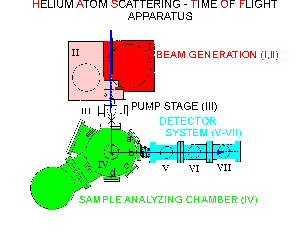[Back to the First Page]
[Research Group's Publications]
[Members of the Research Group]
[>>>]

HAS-TOF
Helium Atom Scattering -
Time of Flight Spectroscopy
(Dr. W. Theis, H. Tröger)

Research Fields
The Helium Scattering Apparatus
Some Results
Research Fields
Helium Atom Scattering is a versatile tool in investigating structural and
dynamical properties of surfaces.
If one deals with insulators, materials sensitive to irradiation of
light or certain particle beams (as LEED, e.g.), or with
adsorbate systems in the regime of physisorption, HAS possibly becomes
one of the most powerful methods.
The low energies of the thermal He atoms well below 100 meV make HAS
absolutely surface sensitive (only the first layer is visible) and
completely non-destructive. Information about the surface structure
and the corrugations of well ordered crystalline species
or systems with defects are obtainable as well as structural properties
of adsorbates even in the submonolayer-range.
Time of Flight Spectroscopy allows one to determine low energetic surface
vibrations as, e.g., the Rayleigh phonon branch or low-lying optical modes
over the entire Brillouin zone and vibrational properties of adsorbate
systems.
Employing HAS we made investigations
of the (111) surfaces of two insulating materials of the Fluoride structure:
CaF2
and BaF2.
In the case of CaF2 we were able to show that
irradation with electron beams
causes point-like defects.
Another focus was the adsorption of water: A surprising
p(4x4)-structure of nanoclusters
on the perfect surface at low temperatures was observed.
Defect-induced
adsorption on an electron-irradiated surface
was found to occur even at room temperature.
Concerning BaF2 two optical vibrational branches were observed
and could be explained with a simple force-constant model.
The current topics of our work are the growth of Fe on MgO(100) and the
magnetic properties of thin Fe films.
The Helium Scattering Apparatus


All experiments were carried out in the vacuum system shown in the above
figures. More detailed ones are available by clicking on them.
The major components of the apparatus are the high vacuum
beam generation part (I-III, the differential pumpinge stage III is not
visible in the photography), the UHV sample preparation and analysis
chamber (IV) and the three stage flight path and detector system (V-VII).
The Beam Generation Part
The creation of a highly expanded, nearly monoenergetic beam of He atoms
(less than 1 meV energy width) takes place mainly in the stages I and II.
A self-constructed He reservoir and nozzle system provides He gas with
stagnation pressures up to 100 bar. The temperature of the system can be
varied via a 2-stage coldhead between 30 K and 300 K, which corresponds to
beam energies of 5 to 60 meV. An electron microscopy aperture (5 mu diameter)
is used as nozzle, through which the He expansion into the high vacuum of
stage I is realised. A conical shaped aperture between stages I and II
(Skimmer) extracts the centre part of the He beam. After this extraction
the expansion is nearly finished and the He atoms, now moving with the same
velocity, do not interfere with each other any more.
Stage II also contains a multi-slit chopper system, which creates beam pulses
necessary for the TOF measurements, and an aperture system, which defines the
beam diveregence.
Stage III is a differential pumping stage with a gate valve.
The Sample Analysis Chamber
In all experiments the scattering angle (angle between incoming beam and
detector arm) remains fixed. So for changing the momentum transfer the
sample has to be rotated polar, which changes the angle between surface
normal and both incoming and outgoing beam. Furthermore, the sample has to
be carefully placed and adjusted in the scattering centre. This is now
reached by a 6-axis manipulator (X,Y,Z and polar, azimuthal and
flip-rotation) with double-differentially pumped rotation flanges.
The precision of the polar rotation is better than 0.01 deg.
The sample temperature can be varied between 150 K and 1000 K.
The sample analysis chamber is additionally equipped with LEED/AES,
sputter-facilities, a metal evaporator and a crystal cleaver.
Flight Path and Detector Part
The flight path is connected via a flexible hose to the sample recipient.
Four different ports (a-d) can be used, so that the scattering angle can be
varied from 56 deg to 180 deg. Even out-of-plane movement of the hole detector
arm is possible. All flight path stages are separately pumped by turbo
molecular, diffusion and rotation pumps. The detector consists of a Balzers
QMG 420 mass spectrometer, which is mounted in the last stage (VII).
It can be fine adjusted.
[Back to the First Page]
[Research Group's Publications]
[Members of the Research Group]
[<<<]
This page is made by Dr. G. König.
Contact:
wolfgang.theis@physik.fu-berlin.de
(Last modified: 12.03.1999)



